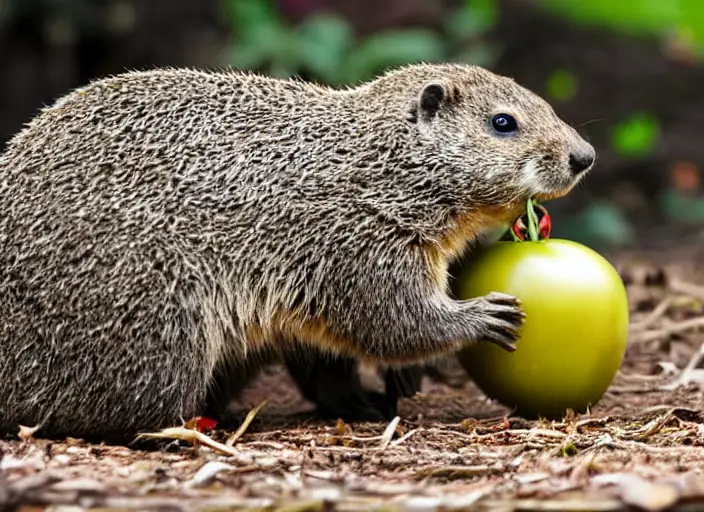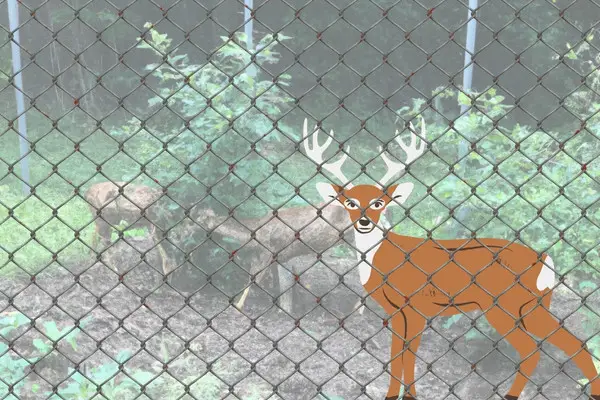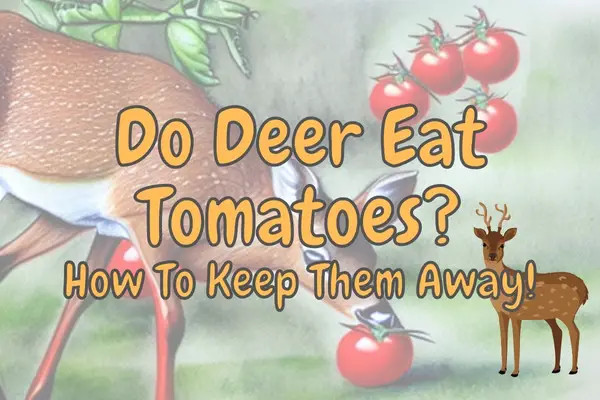This is a question that many yard owners want to know the answer to because their tomato plants seem to disappear at night, or they see traces of deer in their yard. The short answer is yes, deer do eat tomatoes. However, they also eat other fruits and vegetables as deer are herbivorous animals.
In short, deer will eat tomatoes, even unripe ones if available. They will also eat tomato plants, but in smaller amounts as these plants are slightly toxic to deer. The tomato plant belongs to the nightshade family and contains the toxin solanine, but deer can eat a substantial amount before they suffer negative effects.
So if you see deer around and your tomato plants are gone, they are like the culprits!
If you are having trouble with deer in your tomatoes, I will also teach you how to keep them away from your yard!
Tomatoes are a fruit and the deer is not picky when it comes to fruits and vegetables.
Deer will eat and drink the juice from your tomato plants, but they do not typically eat them entirely.
They like to use tomatoes as a way of getting water and nutrients in one go which makes it easier for them to survive.
Do deer only eat ripe tomatoes?
Ripe tomatoes are not too sweet for deer and they contain more energy, so they usually eat ripe tomatoes if they can get hold of them. However, they will also eat unripe tomatoes if they are available.
However, like the plant itself, green tomatoes are slightly toxic and will not be eaten as readily as the ripe red ones by most deer.

Deer are generally not very picky when it comes to their food and will eat whatever is available to them.
Because deer are most active at night and during the early or late daylight hours, they will often go unnoticed.
Watch a deer eating a farmer’s tomato plants at night in the video below:
Why do Deer Like Tomatoes?
Deer loves eating tomatoes because they are a perfect mix of water and fruit. Deer will drink the natural water content from your tomato plants to survive as well as eat the fleshy part of the fruit for their dietary purposes.
Deer eat almost any plant that we would eat and if you have other plants in your garden or yard, make sure to keep them out of reach of the deer as well.
Deer will not likely go out of their way to eat your vegetables, but if it is in the area they are foraging in then there is a good chance that they will try to eat it.
What other animals could have eaten my tomatoes?
Deer aren’t the only animals that like to eat tomatoes in your backyard. Other common ones in North America include raccoons, groundhogs, gophers, rats, opossums, skunks, squirrels, and rabbits.
But deer in particular are especially fond of eating tomato plants because they offer a balance of easily accessible water and nutrients in one place.
Some backyard birds may also love eating tomatoes, but they tend to inflict less damage due to their smaller sizes.
Also, they are typically not bold enough to come close to your plants since there is a high chance that you will scare them away with your presence during the day, whereas deer will mostly forage during the early mornings and evenings when you are not around.

Finally, other rodents like rats or gophers are also attracted to a yard with vegetables and will not hesitate to eat the nice and juicy tomatoes you have spent so much time growing.
Gophers will not only eat them above ground but will also eat tomato plants by the roots from their tunnels underneath!
But luckily, deer cannot stay underground for weeks or months like groundhogs can, especially during winter, so you will have to be ready when they come out in spring!
How do I protect my tomato plants from deer?
There are several ways to prevent pests like deer from invading your backyard. I will go through my favorite methods here.
1. Motion-activated sprinklers
Like most animals, deer hate surprises, and they will run away if suddenly sprayed with water. I like this solution because it is humane, simple, effective, and does not require much time to set up and there are many models to choose from.
The Havahart 5277 is a motion-activated sprinkler that is activated by the movement of animals up to 25 feet away and sprays them with a harmless water jet, frightening them off and keeping them at bay.
The included metal stake makes it easy to install in your backyard, and the sprinkler can be rotated 180 degrees for maximum coverage.
2. Ultrasonic Sound Emitters
Deer, as well as other animals that may invade your backyard, tend to have very good hearing. This means that loud or consistent noises will scare them away or at least shorten their visits significantly!
One of my favorite technologies to keep pests away from my backyard is these cool solar-powered ultrasonic sound emitters that you can buy right from Amazon!
In my experience, they really work, and the solar panels on top save you the time and money of changing batteries all the time.
3. Using Lights and Reflections
Deer are most active at dawn and dusk so they may avoid areas that have bright lights. Motion-activated lights, sounds, and sprinklers may help prevent deer from entering your yard.
Placing CDs or tin foil and mirrors around your yard is another cheap and effective way to create light reflections that blind and scare deer away from your tomatoes.
This may sound a little old-fashioned but it still works! The reflective surface of CDs or tin foil drives deer crazy and will make them seek away from your plants.
You can use old CDs you no longer need or aluminum trays from takeaway containers, just make sure they reflect light well.
If you have a lot of plants to protect this way, it may be a good idea to invest in some commercial mirrors or electronic light emitters like the ones shown above.
4. Build a Fence
The most obvious and practical solution to protecting your plants from deer is to install a fence around the patch. A fence should be at least 6 feet tall and sunk in the ground about 8 inches.

The best fencing material for this purpose is a cattle panel or hog panel as they are very sturdy and can withstand even quadruped animals such as goats, cows, and deer.
However, most chicken fencing types will do. This will be strong enough to stop them from getting through while still allowing for airflow and sunlight.
If you don’t like the idea of building a fence around your entire onion patch then you can try fencing off only the area that your onions, tomatoes, or zucchinis are in; this will at least keep some of the deer, groundhogs or gophers away from them.
5. Using Hot Pepper Or Garlic Spray
This is a good way to protect your vegetable plants or decorative flowers against pests such as gophers, rabbits, groundhogs, and deer. It will also protect your backyard against the neighbor’s cat that thinks it is fine to use your vegetable garden as a toilet.
You only need about 1 tablespoon of crushed chili pepper and garlic along with 1 cup of vinegar per half a gallon of water.
Spray this mixture on any exposed parts of the plant until completely covered. Make sure you reapply whenever rain washes away the spray.
6. Use Deer Deterring Companion Plants
Instead of making a tincture out of strongly smelling plants, you can also just plant the plants themselves!
Companion planting is a good way of deterring animals like deer from your garden. You can plant strong-smelling plants such as garlic, basil, lavender, and chives around your favorite vegetables.
These plants will keep animals like deer, gophers, and mice away because they don’t like the smell of these and they mask the smell of the delicious plants.
7. Use Deer Repellents
You can use some of the commercially available repellents to protect your vegetable plants against deer, gophers, and other animals eating your tomatoes.
You will need to be careful when using these though because some of them can end up harming you and your pets if not applied properly. Some of the commercial deer repellents available include Shake-Away, Bonide Repels All, Critter Ridder, and Tom Cate Repellent.
Green Screen is my favorite one as it comes in small bags that you place around your tomato plants. It is safe and easy to use with all edible plants in your garden!
Watch how Farmer Dean uses the Green Screen repellent to keep away deer from his tomatoes in this video:
8. Using a Scarecrow
Scarecrows may look a little funny in your garden, but they work surprisingly well. Just make sure your scarecrow is big and scary enough to deter deer from getting anywhere near your tomatoes, zucchini, or backyard flowers!
Also, you may need to replace the scarecrow every now and then as deer will get used to it.
9. Using Mothballs
Mothballs are another type of commercial repellent that works well to protect your vegetables and other plants against deer.
This is, however, not our favorite technique as it is less effective and risks spreading toxins in your garden.
You just need to scatter a few mothballs around into the favorite entrance places of the deer to prevent them from coming out and they will eventually leave your garden!
Just be careful where you scatter the mothballs because the compounds (naphthalene or paradichlorobenzene) are quite toxic so don’t put them too close to vegetables or water sources.
Conclusion
As you can see, deer will eat tomatoes and tomato plants. However, they are not the only animals that like to eat tomatoes. Other common ones in North America include raccoons, deer, groundhogs (which I wrote about here), rats, opossums, skunks, squirrels, and bears.
There are several ways to protect your tomato plants against deer including using onion bags around the plant or spreading deer-repellent granules around the area.
You can also use fencing (chicken fencing is usually sufficient) to keep deer away from your tomato plants. Finally, you can use lighting and reflective materials to scare deer away from your tomato plants.
While traps may be dangerous to pets or children if not properly monitored and repellants can be expensive, toxic, and take time to work. Fences are a good option if you have the space, but they may not be practical in all situations.
Scare tactics such as making loud ultrasounds or using reflectors and scarecrows are probably more effective long-term solutions



















